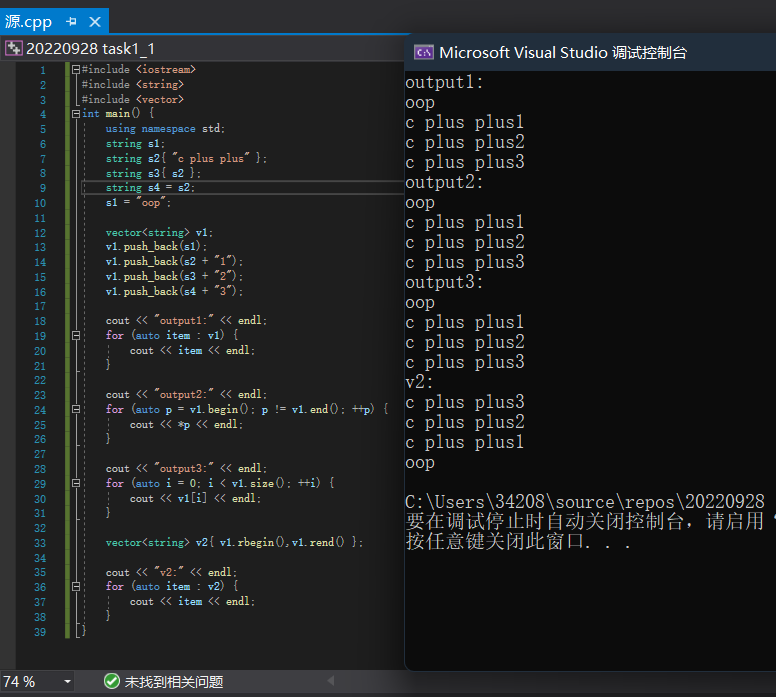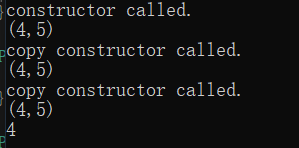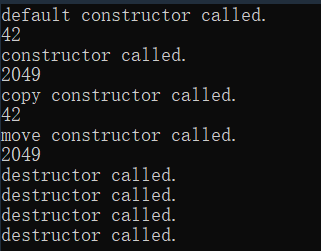实验一
实验任务1
task1_1:
#include <iostream>
#include <string>
#include <vector>
int main() {
using namespace std;
string s1;
string s2{ "c plus plus" };
string s3{ s2 };
string s4 = s2;
s1 = "oop";
vector<string> v1;
v1.push_back(s1);
v1.push_back(s2 + "1");
v1.push_back(s3 + "2");
v1.push_back(s4 + "3");
cout << "output1:" << endl;
for (auto item : v1) {
cout << item << endl;
}
cout << "output2:" << endl;
for (auto p = v1.begin(); p != v1.end(); ++p) {
cout << *p << endl;
}
cout << "output3:" << endl;
for (auto i = 0; i < v1.size(); ++i) {
cout << v1[i] << endl;
}
vector<string> v2{ v1.rbegin(),v1.rend() };
cout << "v2:" << endl;
for (auto item : v2) {
cout << item << endl;
}
}
运行结果:

task1_2:
#include <iostream>
#include <string>
#include <vector>
#include <cmath>
#include <cstdlib>
#include <time.h>
template<typename T>
void output(const T& obj)
{
for (auto item : obj)
std::cout << item << " ";
std::cout << std::endl;
}
int main()
{
using namespace std;
vector<int> v1{ 1, 9, 8, 4 };
v1.insert(v1.begin(), 2022);
v1.insert(v1.end(), 2023);
cout << "v1: ";
output(v1);
v1.pop_back();
v1.erase(v1.begin());
cout << "v1: ";
output(v1);
vector<string> v2{ "《1984》", "《动物农场》", "《美丽新世界》" };
cout << "v2: ";
output(v2);
}
运行结果:

实验任务2:
task2:
#include<iostream>
using namespace std;
class Point{
public:
Point(int x0 = 0, int y0 = 0);
Point(const Point& p);
~Point() = default;
int get_x() const { return x; }
int get_y() const { return y; }
void show() const;
private:
int x, y;
};
Point::Point(int x0, int y0) :x{ x0 }, y{ y0 }{
cout << "constructor called." << endl;
}
Point::Point(const Point& p) : x{ p.x }, y{ p.y }{
cout << "copy constructor called." << endl;
}
void Point::show() const {
cout << "(" << x << "," << y << ")" << endl;
}
int main() {
Point p1(4, 5);
p1.show();
Point p2 = p1;
p2.show();
Point p3{ p2 };
p3.show();
cout << p3.get_x() << endl;
}
实验结果:

实验任务3:
task3:
#include <iostream>
#include <iomanip>
using std::cout;
using std::endl;
class Clock {
public:
Clock(int h = 0, int m = 0, int s = 0);
Clock(const Clock& t);
~Clock() = default;
void set_time(int h, int m = 0, int s = 0);
void show_time() const;
private:
int hour, minute, second;
};
Clock::Clock(int h, int m, int s) : hour{ h }, minute{ m }, second{ s } {
cout << "constructor called" << endl;
}
Clock::Clock(const Clock& t) : hour{ t.hour }, minute{ t.minute }, second{ t.second } {
cout << "copy constructor called" << endl;
}
void Clock::set_time(int h, int m, int s) {
hour = h;
minute = m;
second = s;
}
void Clock::show_time() const {
using std::setw;
using std::setfill;
cout << setfill('0') << setw(2) << hour << ":"
<< setw(2) << minute << ":"
<< setw(2) << second << endl;
}
Clock reset() {
return Clock(0, 0, 0);
}
int main() {
Clock c1(12, 0, 5);
c1.show_time();
c1 = reset();
c1.show_time();
Clock c2(c1);
c2.set_time(6);
c2.show_time();
}
实验结果:

实验任务4:
task4:
#include <iostream>
// 定义一个简单抽象类
class X{
public:
X();
~X();
X(int m);
X(const X& obj);
X(X&& obj) noexcept;
void show() const;
private:
int data;
};
X::X(): data{42} {
std::cout << "default constructor called.\n";
}
X::~X() {
std::cout << "destructor called.\n";
}
X::X(int m): data{m} {
std::cout << "constructor called.\n";
}
X::X(const X& obj): data{obj.data} {
std::cout << "copy constructor called.\n";
}
X::X(X&& obj) noexcept: data{obj.data} {
std::cout << "move constructor called.\n";
}
void X::show() const {
std::cout << data << std::endl;
}
int main() {
X x1;
x1.show();
X x2{2049};
x2.show();
X x3{x1};
x3.show();
X x4{ std::move(x2) };
x4.show();
}
运行结果:

实验任务5:
task5:
#include <iostream>
#include <iomanip>
class Rectangle {
public:
Rectangle();
Rectangle(double l, double w);
Rectangle(const Rectangle& rect);
~Rectangle();
double len() const;
double wide() const;
double area() const;
double circumference() const;
void resize(double times);
void resize(double l_times, double w_times);
private:
double length, width;
};
Rectangle::Rectangle():length{ 2.0 }, width{ 1.0 } {}
Rectangle::Rectangle(double l,double w):length{l},width{w}{}
Rectangle::Rectangle(const Rectangle& rect) : length{ rect.length }, width{ rect.width }{}
Rectangle::~Rectangle(){}
double Rectangle::len() const {
return length;
}
double Rectangle::wide() const {
return width;
}
double Rectangle::area() const {
return length * width;
}
double Rectangle::circumference() const {
return 2 * (length + width);
}
void Rectangle::resize(double times) {
length *= times;
width *= times;
}
void Rectangle::resize(double l_times, double w_times) {
length *= l_times;
width *= w_times;
}
// 普通函数, 用于输出矩形信息
void output(const Rectangle& rect) {
using namespace std;
cout << "矩形信息: \n";
cout << fixed << setprecision(2);
cout << "矩形的长: " << left << setw(6) << rect.len() << endl;
cout << "矩形的宽: " << left << setw(6) << rect.wide() << endl;
cout << "矩形的面积:" << left << setw(6) << rect.area() << endl;
cout << "矩形的周长:" << left << setw(6) << rect.circumference() << endl;
cout << endl;
}
// 主函数,测试Rectangle类
int main() {
Rectangle rect1; // 默认构造函数被调用
output(rect1);
Rectangle rect2(10, 5); // 带有两个参数的构造函数被调用
output(rect2);
Rectangle rect3(rect1); // 复制构造函数被调用
rect3.resize(2); // 矩形rect3的长和宽同时缩放2倍
output(rect3);
rect3.resize(5, 2); // 矩形rect3的长缩放5倍, 宽缩放2倍
output(rect3);
}
运行结果:


